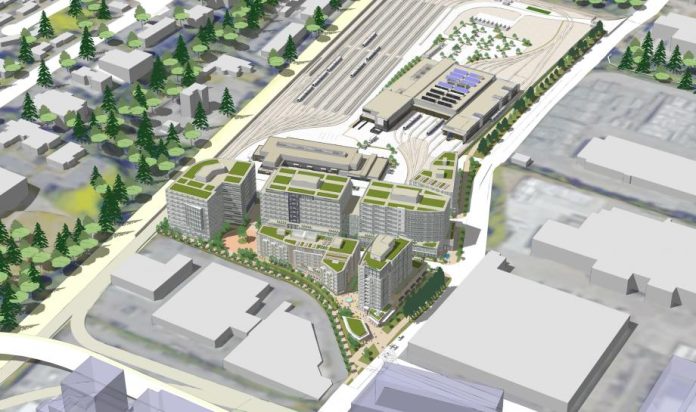
A new transit-oriented development (TOD) in Bellevue could happen on surplus property owned by Sound Transit. The transit agency is actively seeking private bids to develop a 6.88-acre parcel of land next to its Bellevue operations and maintenance facility (OMF East)—which will support the East Link light rail line opening in 2023—and future Spring District station. Earlier this summer, the Sound Transit Board of Directors authorized the property surplus to provide for equitable TOD. They envision more than one million square feet of development, including about 500 homes, with roughly 20% set aside as affordable.
Surplus authorization
The terms of the property surplus authorization stipulated several key actions. Chief among these is disposal of the surplus property for housing development, with a condition that it first be offered to other public entities or nonprofit housing developers to produce affordable housing on the site. This is consistent with state law and agency policy. This grants the flexibility to cooperate with for-profit developers to achieve mixed-use development and the affordable housing objectives. Additionally, some or all of the property may be transferred at a reduced or no cost in order to realize long-term affordable housing objectives.
Another major action is to transfer approximately 0.96 acres of land along the property frontage to the City of Bellevue for free in exchange for the city giving Sound Transit approximately 1.08 acres of land (referred to as the “Spur Property”) at no cost. The frontage property will provide for a multiuse trail, stormwater facilities, and landscaping features. If development of affordable housing does not occur on the Spur Property or related property within four years from transfer to Sound Transit, the City of Bellevue could take the property or commensurate property back at no cost. The agreement with the city does allow for extension, which would likely be authorized for economic reasons or project delays.

Why Sound Transit is surplussing property for TOD in Bellevue
Sound Transit chose the OMF East location in Bellevue for several practical reasons. One primary reason was the size of property available to construct a facility of the OMF’s magnitude on the Eastside. 96 light rail vehicles will be stored and maintained on-site, requiring all manner of support facilities. Near the planned light rail line, there were few properties that met the siting criteria (such as zoning, topography, and arrangement). Even still, Sound Transit had to buy out several businesses and has since removed all structures to make way for the new facility now under construction.
Another major reason for the site was its proximity to the old Eastside Rail Corridor. It directly abuts the Corridor, which provides for an easy, grade-separated tie-in with the East Link line. It also provides strategic connectivity for future light rail to Kirkland that will branch off from East Link at NE 12th St and continue on the Eastside Rail Corridor.
However, Sound Transit did not end up needing all of the site for the OMF. Thus, the transit agency is now surplussing the remainder.
Sound Transit’s conceptual TOD plans
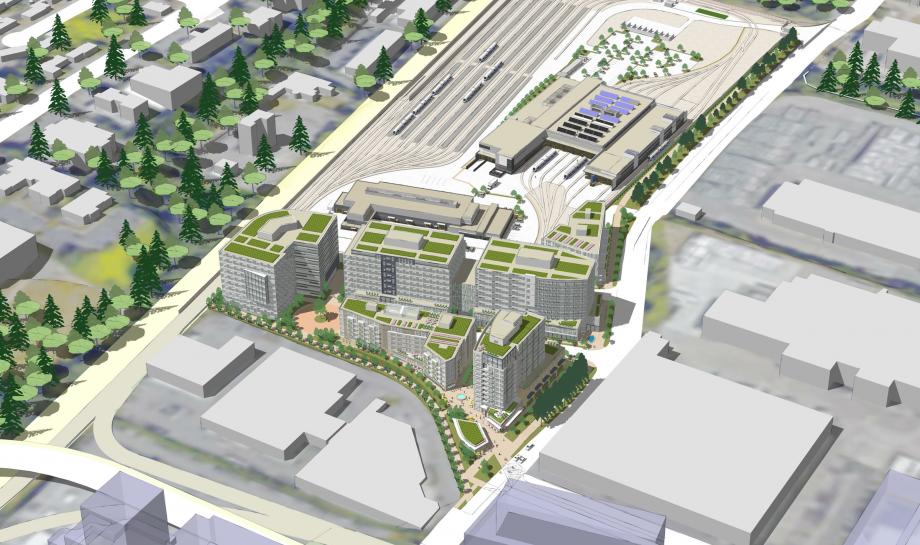
Based upon appraisals conducted by Sound Transit, the total fair market value of the surplus property is estimated at $36 million. The transit agency estimates that approximately 1.11 million square feet of development–110,000 square feet of which would be dedicated to affordable housing–could be accommodated on the property.
Approval has been given through a Master Development Plan on the TOD site for six buildings. These would be split: three as apartment buildings and three for office use. Sound Transit’s advertising materials for private developer proposals indicate that approximately 500 dwelling units, 650,000 square feet of office space, and 60,000 square feet of retail could be constructed on the property.
Through a partnership with King County and A Regional Coalition for Housing (ARCH), up to $14 million will be provided for affordable housing development capital funding on-site. King County’s share would be the higher of the two, at $10 million, while ARCH would fund $4 million. The transit agency has also already promised that about $12 million in land value will be discounted to help create on-site affordable housing. At least 80 dwelling units will be set aside for households making at or below 60% of the area median income.
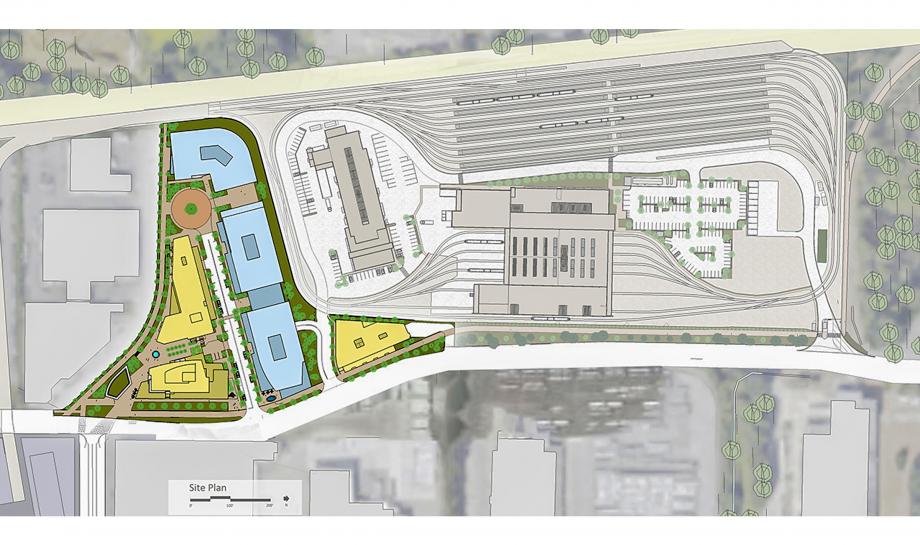
Taking the appraised fair market value of the property plus the discount into consideration suggests that the property could sell for around $24 million. However, open bid information entertains the possibility of long-term ground leases for some or all of the site instead of strictly selling the land. If ground leases are sought, Sound Transit would likely fetch a lower initial payout from developers but would have the benefit of ongoing lease payments over time. Sound Transit would also hold the property in perpetuity, making for a better long-term investment.
Portions of the TOD site will be set aside for open space and outdoor uses. The overall concept layouts that Sound Transit has released suggest that the development will be highly pedestrian-oriented. Two vehicular accessways would be provided from 120th Ave NE, but the streets appear to be designed for slower car movements. Internal site permeability will grant exclusive use to people walking, rolling, and biking. The TOD site also happens to abut the Cross Kirkland Trail, which will be improved in coming years.
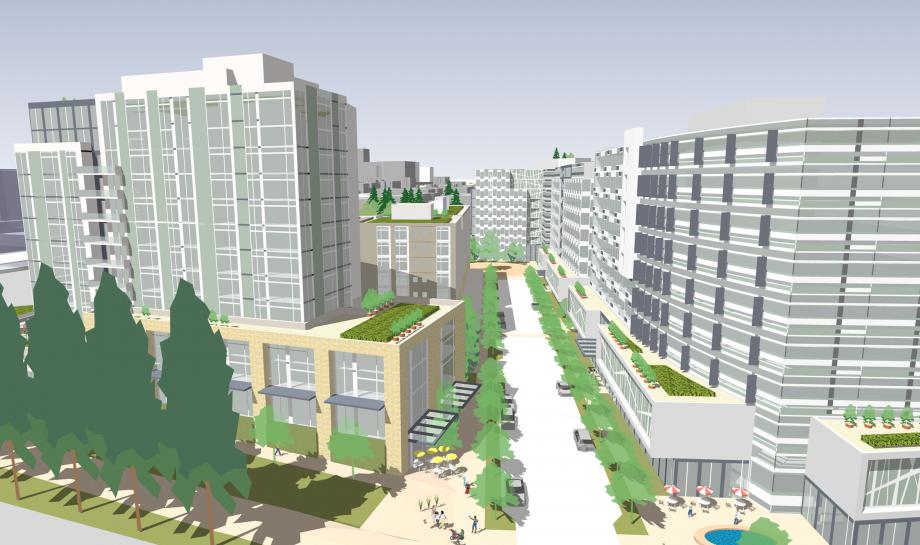
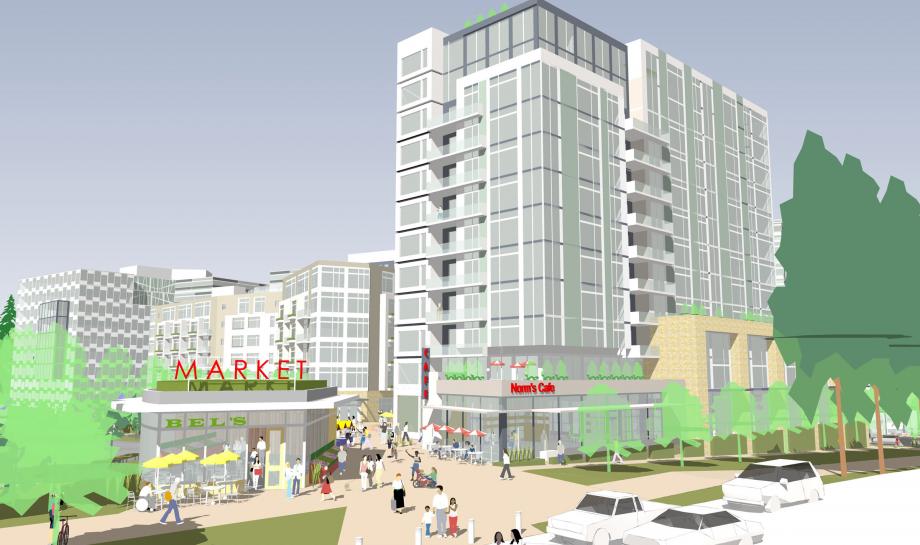
Sound Transit has rendered the conceptual landscape plan and buildings that will fill the TOD site. The renderings indicate that buildings could reach up to 12 stories and that the site will be heavily vegetated with trees and groundcovers.
A big benefit of the TOD site is that Spring District, the nearest light rail station, will be located just across the street at 120th Ave NE. Functionally, the TOD site would build upon the Spring District master-planned development–one of the busiest redevelopment locations along East Link.

The TOD site’s relationship to the Spring District
Until recently, much of the Spring District and Bel-Red were used for large industrial, manufacturing, storage, and warehousing facilities. Profitable and in-demand mixed-use redevelopment is quickly taking hold, spurring existing businesses and property owners to sell in droves. For its part, the Spring District is growing around the future light rail station on the blocks between 120th Ave NE, NE 12th St, 124th Ave NE, and the Metro bus base.

Wright Runstad & Company, which entitled the development plans for the Spring District, received approval in 2012 for a mixed-use district encompassing 36 acres of land with 24 buildings. Up to 5,300,000 square feet of leasable space is expected, translating to over 1,500 dwelling units and 3,000,000 square feet for office and retail space. An early phase of development has already been completed and several midrise apartment and office buildings have been occupied, including space for technology school Global Innovation Exchange. REI and Facebook also plan to occupy office space soon. On balance, the district will be business-oriented, with around 13,000 employees and 2,000 residents—much like Downtown Bellevue and Overlake.
While the Spring District is already well on its way to making use of the new light rail station and extension on opening day, it remains to be seen whether the same will be true for Sound Transit’s TOD site. The bidding process is open through February and it will take some time to prepare and finalize contracts. Permitting for civil construction and building plans will also take at least a year before ground can even be broken. Can construction wrap up before 2023? Maybe, but they will have to get a move on it.
Stephen is a professional urban planner in Puget Sound with a passion for sustainable, livable, and diverse cities. He is especially interested in how policies, regulations, and programs can promote positive outcomes for communities. With stints in great cities like Bellingham and Cork, Stephen currently lives in Seattle. He primarily covers land use and transportation issues and has been with The Urbanist since 2014.

